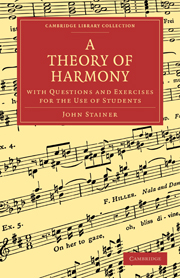Summary
PASSING-NOTES, SEQUENCES. &c.
272. Many combinations as well as progressions of sounds seem almost inexplicable until the three following facts are known:—1st, That the ear is so accustomed to the succession of the notes of the scale, that it will tolerate such a succession, even when the notes have little or no relation to the harmony with which they are heard; 2nd, that a series of harmonies occurring over successive notes of the scale, or over a regularly recurring phrase made up of scale notes, may contain combinations which would not be borne with, unless built on such a ground-work; 3rd, that a note may be sustained through a succession of chords, to which it is but slightly related, if only it start as a part of a recognised chord, and if it be eventually legitimately incorporated into the harmony. From the first of the laws arises the consideration of passing-notes; from the second, of the sequence; from the third, of the pedal-point.
273. Probably no word has been so much and so wrongly used by severe musical lawgivers as the word “passing-note.” Whenever a combination of notes existed which ought not to have existed, in their judgment; if the unrecognised discordant note happened to be, as it often of course must have been, between successive degrees of a scale, this note was termed a passing-note, and the rest of the chord was taken into consideration without it. […]
- Type
- Chapter
- Information
- A Theory of HarmonyWith Questions and Exercises for the Use of Students, pp. 141 - 152Publisher: Cambridge University PressPrint publication year: 2009First published in: 1876



